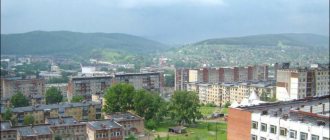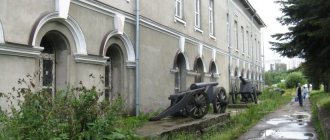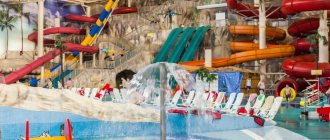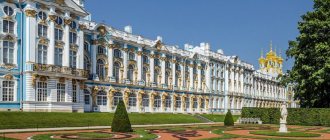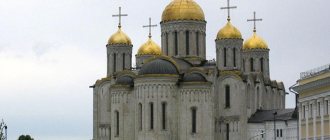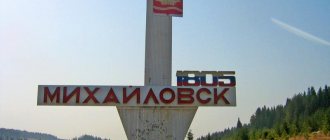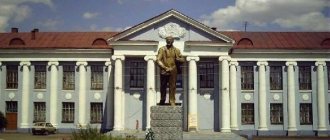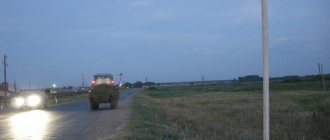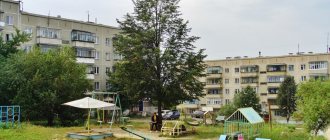The small and cozy South Ural town of Kusa is located in a picturesque location on the right bank of the Ai River.
It got its name from the river at the mouth of which it arose. The length of the Kusa River is 59 kilometers. According to linguists, the name of the river comes from the Turkic word “kucheu” - “to roam”. There is also a bolder assumption, according to which the toponym could have arisen from the Iranian word “kucha” - “village”.
History of Kusa
The modern history of these places began in the 18th century. In 1754, industrialists Mosolovs bought the “Kusinsky place” on the Kusa and Ai rivers from the Bashkirs. In the 1760s, the Mosolovs submitted a petition to the Berg College asking for permission to build an ironworks. However, another plant owner, Larion Luginin, opposed this, since the Zlatoust plant that belonged to him was less than 50 miles away. As a result, in 1770, the Mosolovs were forced to sell the “Kusinsky Place” to L.I. Luginin.
In May 1778, construction of a plant began on the Kusa River near Mokhovaya Gora. The river was blocked by a dam, and a hammer factory and factory village grew up. The finished metal was sent by water. On the right bank of the Ay, near the Lipovye Mountains, a shipyard for the construction of barges and a pier arose. Later, in 1812, the “Baroque Pier” was moved 2.5 kilometers downstream of the Aya - to Igoshina Mountain, where the “New Pier” appeared.
In 1797, the plant was leased to the Moscow merchant A.A. Knauf. In 1799, a blast furnace began operating at the plant, thanks to which the Kusinsky plant became a full-cycle enterprise.
In 1812, the Kusinsky plant (along with others owned by A.A. Knauf) was transferred to the treasury, becoming part of the Zlatoust mining district. In 1828, the Akhtensky mine was opened, which became one of the main suppliers of iron ore for the enterprise.
On June 26, 1862, a tragedy occurred in Kusa: as a result of heavy rains, the dam was washed away, which led to destruction at the plant. The plant resumed operation in 1863, but not at full capacity.
In 1883, the Kusinsky plant mastered the production of artistic products from cast iron, competing with the famous Kasli iron casting. Kusa products received high awards at international exhibitions. Kusinsky artistic casting received its first recognition in 1888 at an exhibition in Copenhagen, and the Kusinsky plant also took part in exhibitions in Stockholm (1897) and Glasgow (1901). In 1906 in Milan they received the highest award. Most of the Kusa products were cast according to the same samples as in Kasly, but there were also their own, purely Kusa items. Among them are the “Worker in a Hard Hat” inkwell, the “Magnolia Flower” ashtray, a plaque with the image of Leo Tolstoy, solid cast boxes, etc.
In 1904 V.A. Vesnovsky wrote in his “Guide to the Urals”:
“The Kusinsky plant is located at the confluence of the Kusa and Ay rivers, which flow here in a narrow picturesque gorge. The plant's production includes smelting cast iron, manufacturing artillery shells and iron. In addition, in recent years the plant has become famous for its artistic casting, rivaling the famous Kasli one. In 1902, the products of the plant were honored to be accepted into the palace of the Sovereign Emperor. The factory produced: busts of their imperial majesties, works by the sculptor Ginzburg, a Nozdrev type, sculptures of Professor Solovyov, a bust of Generalissimo A.V. Suvorov and others. At the Kusinsky plant, statues of Emperor Alexander II for monuments in Zlatoust and Yekaterinburg were cast according to Professor Popov’s model.”
The production of artistic castings continued in Kus during Soviet times. At the beginning of 1920, Kusa workers presented V.I. Lenin received a gift – a table lamp-figurine, which later received the name “Forge of Peace”, and a year later – a figurine of Joan of Arc. In 1937, the Kusinsky plant sent more than 900 tons of architectural castings to the construction of the Moscow metro.
However, in 1927 the plant was repurposed as a machine-building plant. The production of heating units, power plant boilers, furnace equipment, etc. was established. Iron smelting and iron foundries began to fade into the background. Today, the company continues to operate under the name Kusinsky Foundry and Machine-Building Plant.
Since 1930, ore for the plant began to be mined at the Magnitka mine, a titanium-magnetite deposit. A village of the same name arose there. Nowadays, the surroundings of the village of Magnitka are notable for the huge faults in the earth's surface. The terrible zones of collapse of former mines on the mountain near the village are clearly visible even on satellite images.
The surrounding area of Kusa is also famous for its marble. It is mined at the Medvedevsky marble quarry on the banks of the Ai River above Kusa, on the outskirts of the village of Medvedevka. Marble mining began at the turn of the 19th and 20th centuries. He went to cover the façade of the building of the Museum of Fine Arts. Emperor Alexander III in Moscow (now it is the A.S. Pushkin Museum of Fine Arts). In Soviet times, several Moscow metro stations, the V.I. Memorial Complex were faced with this marble. Lenin in Ulyanovsk, Sports Palace in Chelyabinsk.
In 1942, the Peterhof plant of precision technical stones was evacuated to Kusa - the only enterprise in the country at that time producing stones for the watch and instrument-making industries. In 1970, a diamond cutting workshop was established on the basis of the plant. The plant has survived to this day, becoming one of the 10 largest Russian diamond cutters, but in 2015, the ChelProm-Diamond enterprise, one of the owners of which by that time was director Nikita Mikhalkov, was declared bankrupt.
As of 2016, Kus has a population of 17,521.
Sports in the city
There is a hockey team "Yunost". Today, three children's teams, consisting of about 60 children, are training in the Kusinsky district. Young hockey players are trained by N. G. Ovladev and I. A. Yanov. Despite the difficult financial situation, the district and city administrations, as well as the Physical Education and Sports Municipal Budgetary Institution, constantly provide assistance to hockey players. Employees of the Rubin and Trud stadiums help the competitions. K: Wikipedia: Articles without sources (type: not specified)[ source not specified 1971 days
].
Sights of Kusa
Perhaps the most interesting architectural landmark of Kusa is the brick house of the manager of the Kusinsky plant , standing on a hill near the pond dam. The house was built in 1895. The cast iron decor of the house, which adorns both porches, is of interest. Cast iron gratings with floral patterns, porches, and parapets appeared in 1909-12. In Soviet times, in different years the building housed the volost and village councils, the headquarters of the military squad, the district committee of the CPSU, the House of Pioneers, and a station for young technicians. Unfortunately, after the fire, the building was abandoned and is gradually collapsing. And in May 2022, local bandits stole cast iron elements from the porch of the house. They did not have time to sell the cast iron decor - they were detained.
In the past, there was a monument to Stalin nearby. Interestingly, in the summer of 2022, he was unexpectedly discovered at the bottom of a shallow pond. After the cult of personality was debunked, the monument was broken and thrown into the water, where its fragments lay for more than half a century.
Surprisingly, in small Kusa there is even a local Arbat ! Part of the main city street, M. Bubnova, was made pedestrian. Curved paving slabs were laid here, benches were installed, and lanterns and trash cans were installed. Kusinsky Arbat was decorated with sculptures in the form of a retro car, an umbrella, a seven-flowered flower, and a peacock. There is also a bench of reconciliation in a figured metal heart. Children can play on the playground. And information stands tell about some moments of the city’s history and honorary citizens. The pedestrian street became a place for mass celebrations among Kusin residents. In the summer, concerts are held here.
The city has a small Museum and Local History Center located in the Palace of Culture. It began in 1967 with the Museum of Art Casting. The museum's collections include antiques, artistic castings, sculptures, ancient coins, etc. Address: st. Bubnova, 4. Tel. (35154) 3-45-01, 3-31-06.
Interestingly, one of the parts of the city is still called Baroque. In this part of the city, on the left bank of the Kusa River, there is an architectural monument of the 19th century - the Holy Kazan Church (Kommunar St., no. 1). It was built in 1882.
And one more interesting fact. In the small town of Kusa you can find three monuments to V.I. Lenin: on the city square, near the city administration (M. Bubnov St., 16) and in the park named after. Vanina.
The main natural attraction of Kusa is the majestic Argus rock on the Ai River. It stands on the right bank of the river, at its turn. In the past, during the times of rafting of iron caravans, barges were carried by the current straight onto a stone cliff. Some ships did not have time to row, which led to misfortunes.
The name of the cliff is associated with the name of one of the characters in Greek mythology - the many-eyed giant Argus. According to legend, he overcame the monstrous bull that devastated Arcadia, and also strangled the snake Echidna.
In front of Argus, a picturesque ravine opens out to the river. A stream flows through it, a few meters before the Ai River, falling from the rocky wall as a small waterfall. A path descends along the ravine leading from the houses of Kusa and the railway to the Ai River near the foot of Argus. From here the view of the massive silhouette of the handsome stone Argus is especially impressive! There is a grotto at the base of the rock.
It's worth going up. From above you understand that Argus runs along the river along a high and rather narrow ridge, breaking off on both sides. A beautiful pine forest grows on the mountain.
This place is a geological natural monument of the Chelyabinsk region. Here the geological section of Riphean deposits comes to the surface. The cliff is the remains of a reef with colonies of blue-green algae - stromatolites.
In 1856, Argus was visited by the famous geologist E.K. Hoffmann (mistakenly calling him Arbus). Later, in an article in the Mining Journal (Book IV, 1868), he writes:
“...It rained until the morning of August 5th. On this day I took advantage of one of the clear periods of time to make a short trip to Ai. I approached the river near a steep limestone bank called Arbus. Before this, only gray-blue limestone is found, the layers of which dip to the east, as can be seen in many small quarries from which stones are quarried for the foundations of buildings. In this dense gray-blue limestone there are separate darker earthy layers, which are divided into thin leaves and contain nodules that bear an unusual resemblance to organic remains, as they may actually originally have been. In shape they are mostly similar to a wide compressed shell of a terebratula or the like; on one side of the layer they form bulges or elevations, and on the other side - small depressions corresponding to them. They are divided into convex layers from the surface, so that the inner layers become larger as they move away from the surface, but the real core is not visible ... "
On the mountain, between Argus and Kusa, there is a single-track railway to the Kusinsky plant. During the construction of the road, small rock excavations were cut into the mountain near Argus, which can also be examined if desired.
Downstream of the Aya from the Argus rock, a railway bridge was built in the first half of the 1910s. At this point, the Ai River is crossed by the Western Ural Railway, opened in 1916 with the goal of connecting the Lysva station and the Berdyaush station of the Samara-Zlatoust Railway in order to facilitate Ural factories access to raw materials - deposits of iron ore and coal. A station village was formed nearby at Kusa station. One of the battles took place here during the Civil War.
In the past, in the clearing below the station village there was a summer camp of the Kusinsky boarding school for disabled children. Now its ruins are still visible. And before the revolution, there was a favorite vacation spot for the Kusin residents - the so-called Jewish Zaimka.
Near Kusa, on Mount Kopanets (601 m), the Eurasia Active Recreation Center was recently built with several ski slopes and a variety of services.
The rafting route along the amazingly beautiful Ai River begins from Kusa. You can learn about the many attractions of this river on the rafting route from Kusa to Laklov, as well as additional interesting information about the city of Kusa from the book “Ai River” . You can purchase it from the author. Write by email The email address is being protected from spambots. Javascript must be enabled in your browser to view the address. or a personal message on social networks. Books about the Serga, Chusovaya and Vishera rivers have also been published.
Transport
City transport is represented by two bus routes 1 - Barochnaya-Station-City Hospital. 2 - Cape Panichev Klyuch-Barochnaya. Intercity bus service with Chelyabinsk, Zlatoust, Yekaterinburg, suburban - with Magnitka, Zlokazovo, Petropavlovka and Medvedevka. A railway passes through the city with the Kusa station of the Nyazepetrovskaya route of the Zlatoust branch of the South Ural Railway. In 2011, two pairs of commuter trains Berdyaush - Mikhailovsky Zavod passed through Kusa. As of 2013, there is no passenger traffic through Kusa.
How to get to Kusa?
To get to Kusa, you need to drive along the M5 highway (Chelyabinsk - Ufa), turn towards the city of Zlatoust (at the same time it’s worth seeing its sights), then, after passing the city, move to Kusa. The distance to Kusa from Chelyabinsk is 178 kilometers, from Yekaterinburg - 280 kilometers, from Ufa - 294 kilometers, from Perm - 434 kilometers. There are regular buses from Zlatoust, Chelyabinsk, and Yekaterinburg to Kusa. In the vicinity of Kusa you can also visit the Devil's Finger rock and the village of Petropavlovka.
Pavel Raspopov
UraloVed.ru
Notable residents
- Vanin, Nikolai Andreevich (1907-1946) - Soviet soldier. Participant of the Great Patriotic and Soviet-Japanese Wars. Hero of the Soviet Union (1945). Sergeant Major[1].
- Shiryaev, Ivan Andreevich (September 29, 1891 - October 30, 1950) - rifleman of the 455th and 459th Verkhnedneprovsky rifle regiments of the 42nd rifle division, Red Army soldier, Full Knight of the Order of Glory.
- Terentyeva, Nina Nikolaevna (born 1946) - opera singer (mezzo-soprano), soloist of the Bolshoi Theater, People's Artist of Russia (1995)
Notes
- ↑ 12
www.gks.ru/free_doc/doc_2016/bul_dr/mun_obr2016.rar Population of the Russian Federation by municipalities as of January 1, 2016 regional significance Asha | Kartaly | Kasli | Katav-Ivanovsk | Ozyorsk | Satka | Snezhinsk | Trekhgorny regional significance Bakal | Verkhneuralsk | Kusa | Minyar | Nyazepetrovsk | Sim | Yuryuzan
